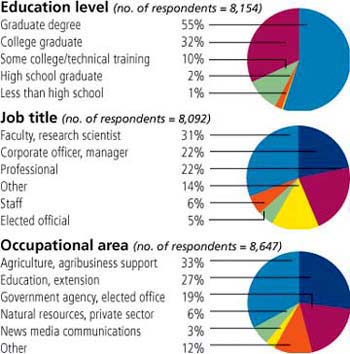All Issues
California Agriculture readers diverse, well-educated
Publication Information
California Agriculture 57(4):100-100.
Published October 01, 2003
PDF | Citation | Permissions
Full text
California Agriculture readers are a well-educated audience of 15,000 business leaders, faculty, scientists and policymakers, a recent survey shows.
In September and November 2002, California Agriculture sent 19,025 U.S. readers a resubscription notice on the dust cover of the magazine and posted similar forms on the Web site. The twofold purpose was to purge subscribers with no current interest, and to collect current information on reader interests and characteristics.
Of recipients, 66% or 12,593 resubscribed. (The balance of the 15,000 are chiefly foreign subscribers.) Of respondents, 87% are college graduates; 55% of readers hold advanced degrees (see figure). Not surprisingly, 31% identify themselves as faculty members or research scientists.
Another 22% describe themselves as either corporate officers or managers. The category of professional — doctors, attorneys and lab technicians, for example — was chosen by 22% of those responding.
Readers also revealed that their occupational fields are broad-based. While a core of 33% work in agriculture (25% in production or processing, 8% in agribusiness), two-thirds work in other areas such as government regulation and research (in water resources or food safety, for example).
“The audience is a good match to content,” says Steve Nation, director of ANR's Office of Governmental and External Relations. “While the journal is peer-reviewed to ensure that the science is sound, the text is edited to be accessible to a cross-disciplinary and professional audience.”
The journal's authors are primarily, but not exclusively, UC faculty who wish to disseminate peer-reviewed research to an audience that extends around the world.
“The profile of readers indicates that California Agriculture performs a broader educational function than faculty normally can achieve with technical publication in a disciplinary journal,” notes Associate Editor Al Sokolow, UC Davis public policy specialist. “It extends significant new research findings to a wider readership, informing decision-makers who are not in the same disciplinary field of important developments.”
In addition to domestic subscribers, there are 1,740 foreign recipients, including 1,323 overseas libraries. International subscribers pay a subscription fee or must request an exception. Of journals sent to foreign libraries, 600 are distributed through UC Berkeley's library exchange program.
"California Agriculture is one of the most important titles of the 70 that we exchange. It is actively used at the institutions to which we send it. It unquestionably extends the University's presence very broadly around the world,” says Frank Carothers, head of the Gifts and Exchange Division of the UC Berkeley library.
While California Agriculture's audience is world-wide, its research focus is primarily on California. As a natural outcome, two-thirds of U.S. subscribers (8,305) live in California.
Readers were asked to check as many work interest areas as applied. They reported their chief interests were agriculture (33%), pest management (29%), the environment (28%), water (26%) and horticulture (26%). Other interest areas were land use (21%), forestry (13%), ranching (13%), food safety (12%), energy (11%) and nutrition (10%).
While the audience is computer savvy (3,173 or 25% resubscribed on line), most said they did not read the magazine online. This is consistent with other research showing that many people read while commuting or during leisure hours, when printed publications are more convenient.
Studies also show that readers prefer to have access to both online and printed sources, with many preferring the Internet to perform research. Close to 2,500 readers submitted their e-mail addresses, and are now receiving e-mail notification of the Web site posting of California Agriculture, with table of contents and links.
Findings reported here are based on approximately 8,000 to 11,000 responses depending on the question. Survey data was compiled and statistically analyzed by Brent Donnellan, former postdoctoral researcher, Human and Community Development, UC Davis. (Donnellan is now an assistant professor at Michigan State University.)
California Agriculture gratefully acknowledges the contribution of the late Associate Adjunct Professor Curt Acredolo, also of Human and Community Development, UC Davis. Acredolo consulted extensively on the postcard design and the input procedures and ideas.
To receive e-mail notification or update subscriber information, go to http://danr.ucop.edu/calag .





